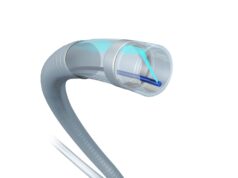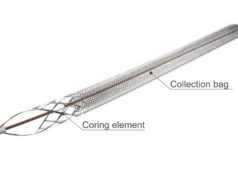
Ash Verma, Clearwater, USA, writes how last year, he happened upon a routine case that struck him as both totally unremarkable and absolutely extraordinary. A 69-year-old female patient presented with one week of swelling and pain in her left arm, notable for a history of lung carcinoma that had, five months earlier, prompted placement of a left subclavian chest port. An ultrasound confirmed occlusive deep-vein thrombosis (DVT) in the patient’s left basilic, brachial, axillary and subclavian veins. A venogram detailed that the occlusive thrombus reached the level of the subclavian vein port catheter entry site.
The ambiguity in our hospital’s algorithm for treating high-risk patients with acute symptomatic DVT has long since been resolved. Catheter-directed thrombolysis (CDT) is superior to anticoagulation therapy, and ultrasound-enhanced CDT has been shown through trial data to be superior to either. Because it accelerates the lysing process by exposing more plasminogen receptors to the lytic agent, ultrasound-enhanced CDT significantly decreases treatment time and dosage. My team and I placed a EkoSonic Endovascular System (EKOS) 30cm infusion-length catheter across the thrombus, delivering one milligram of tissue plasminogen activator per hour and 75ml of coolant per hour. Six hours later, the occlusive thrombus was lysed and we angioplastied the subclavian vein using 10mm and 12mm high-pressure balloons; although underlying venous scarring led to some residual stenosis, brisk flow was subsequently restored within the veins. Forty-eight hours later, the upper-extremity pain and swelling had resolved and we placed the patient on heparin, followed by warfarin. Two months later, the patient was entirely asymptomatic, her port still functioning normally. A year later, the patient remains free of symptomatic re-swelling. I described this case as unremarkable because this sort of brisk, uncomplicated recovery to thrombi of all sorts—from peripheral DVT to pulmonary emboli—is what we have come to expect at my hospital in the years since we adopted ultrasound-assisted CDT as our standard of care in cases such as these.
At the same time, I do not wish to be blasé about the strides that physicians are making in treating these dangerous, commonplace conditions. The 80% reduction in treatment time that I have encountered since adopting ultrasound-enhanced CDT still seems to me truly remarkable, and my experience here is not merely anecdotal. In June’s issue of Cardiovascular and Interventional Radiology, a retrospective single-hospital analysis1 of CDT alone versus CDT with ultrasound enhancement found that the latter was meaningfully associated with improvements in treatment duration, length of hospital stay, and reduced intravenous stenting. The 94 cases of this series provide more clear evidence of the superiority of ultrasound-enhanced CDT in these areas while also illustrating that there are no discernible trade-offs such as an increase in haemorrhages or intracranial bleeds. Indeed, some clinical data2 have shown that the addition of ultrasound and consequent reduction in lytic dosage contribute to a reduction in rates of bleed complications. Randomised controlled trials have similarly endorsed ultrasound-enhanced CDT’s ability to accelerate treatment times and reduce lytic dosage for arterial occlusions (the DUET study3) and pulmonary emboli (SEATTLE II4 and ULTIMA5).
I cannot remember the last time my hospital used catheter-directed thrombolysis that did not include ultrasound enhancement. Certainly, it has been years. I hope that my colleagues soon learn to forget CDT without ultrasound as well.
References
- Tichelaar VYIG, et al. Cardiovasc and Interv Radiol 2016; 39:1115-1121.
- Parikh S et al. J Vasc Intv Radiol 2008;19(4):521-528.
- Marjolein Schrijver A, et al. J Endovasc Ther 2015;22:87-95.
- Piazza G, et al. J Am Coll Cardiol Intv 2015;8(10):1382-1392.
- Kucher N, et al. Circulation 2014; 129:479-486.
Ash Verma is at Morton Plant Mease Healthcare, Clearwater, USA









